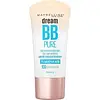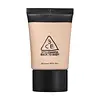What's inside
What's inside
 Key Ingredients
Key Ingredients

 Benefits
Benefits

 Concerns
Concerns

 Ingredients Side-by-side
Ingredients Side-by-side

Water
Skin ConditioningCyclopentasiloxane
EmollientCI 77891
Cosmetic ColorantCyclohexasiloxane
EmollientEthylhexyl Methoxycinnamate
UV AbsorberButylene Glycol
HumectantPhenyl Trimethicone
Skin ConditioningButylene Glycol Dicaprylate/Dicaprate
EmollientDicaprylyl Carbonate
EmollientPEG-10 Dimethicone
Skin ConditioningZinc Oxide
Cosmetic ColorantNiacinamide
SmoothingCyclomethicone
EmollientSodium Chloride
MaskingSodium Hyaluronate
HumectantPearl Powder
Amethyst Powder
AbrasiveTourmaline
Diamond Powder
AbrasivePortulaca Oleracea Extract
Skin ConditioningDisteardimonium Hectorite
StabilisingGlycerin
HumectantPentylene Glycol
Skin ConditioningGlyceryl Behenate/Eicosadioate
EmollientSorbitan Isostearate
EmulsifyingCetyl PEG/PPG-10/1 Dimethicone
EmulsifyingTrimethylsiloxysilicate
EmollientMethyl Methacrylate Crosspolymer
Dimethicone Crosspolymer
Emulsion StabilisingAluminum Hydroxide
EmollientStearic Acid
CleansingTriethoxycaprylylsilane
Acrylates/Dimethicone Copolymer
Skin ConditioningDimethicone
EmollientEthylhexylglycerin
Skin ConditioningAdenosine
Skin ConditioningDisodium EDTA
Phenoxyethanol
PreservativeMethylparaben
PreservativeParfum
MaskingButylphenyl Methylpropional
PerfumingBenzyl Benzoate
AntimicrobialBenzyl Salicylate
PerfumingLimonene
PerfumingCitronellol
PerfumingLinalool
PerfumingCI 77492
Cosmetic ColorantCI 77491
Cosmetic ColorantCI 77499
Cosmetic ColorantWater, Cyclopentasiloxane, CI 77891, Cyclohexasiloxane, Ethylhexyl Methoxycinnamate, Butylene Glycol, Phenyl Trimethicone, Butylene Glycol Dicaprylate/Dicaprate, Dicaprylyl Carbonate, PEG-10 Dimethicone, Zinc Oxide, Niacinamide, Cyclomethicone, Sodium Chloride, Sodium Hyaluronate, Pearl Powder, Amethyst Powder, Tourmaline, Diamond Powder, Portulaca Oleracea Extract, Disteardimonium Hectorite, Glycerin, Pentylene Glycol, Glyceryl Behenate/Eicosadioate, Sorbitan Isostearate, Cetyl PEG/PPG-10/1 Dimethicone, Trimethylsiloxysilicate, Methyl Methacrylate Crosspolymer, Dimethicone Crosspolymer, Aluminum Hydroxide, Stearic Acid, Triethoxycaprylylsilane, Acrylates/Dimethicone Copolymer, Dimethicone, Ethylhexylglycerin, Adenosine, Disodium EDTA, Phenoxyethanol, Methylparaben, Parfum, Butylphenyl Methylpropional, Benzyl Benzoate, Benzyl Salicylate, Limonene, Citronellol, Linalool, CI 77492, CI 77491, CI 77499
 Reviews
Reviews

Ingredients Explained
These ingredients are found in both products.
Ingredients higher up in an ingredient list are typically present in a larger amount.
Dimethicone is a type of synthetic silicone created from natural materials such as quartz.
What it does:
Dimethicone comes in different viscosities:
Depending on the viscosity, dimethicone has different properties.
Ingredients lists don't always show which type is used, so we recommend reaching out to the brand if you have questions about the viscosity.
This ingredient is unlikely to cause irritation because it does not get absorbed into skin. However, people with silicone allergies should be careful about using this ingredient.
Note: Dimethicone may contribute to pilling. This is because it is not oil or water soluble, so pilling may occur when layered with products. When mixed with heavy oils in a formula, the outcome is also quite greasy.
Learn more about DimethiconeDisteardimonium Hectorite comes from the clay mineral named hectorite. It is used to add thickness to a product.
It can also help stabilize a product by helping to disperse other ingredients.
Hectorite is a rare, white clay mineral.
Learn more about Disteardimonium HectoriteGlycerin is already naturally found in your skin. It helps moisturize and protect your skin.
A study from 2016 found glycerin to be more effective as a humectant than AHAs and hyaluronic acid.
As a humectant, it helps the skin stay hydrated by pulling moisture to your skin. The low molecular weight of glycerin allows it to pull moisture into the deeper layers of your skin.
Hydrated skin improves your skin barrier; Your skin barrier helps protect against irritants and bacteria.
Glycerin has also been found to have antimicrobial and antiviral properties. Due to these properties, glycerin is often used in wound and burn treatments.
In cosmetics, glycerin is usually derived from plants such as soybean or palm. However, it can also be sourced from animals, such as tallow or animal fat.
This ingredient is organic, colorless, odorless, and non-toxic.
Glycerin is the name for this ingredient in American English. British English uses Glycerol/Glycerine.
Learn more about GlycerinPhenoxyethanol is a preservative that has germicide, antimicrobial, and aromatic properties. Studies show that phenoxyethanol can prevent microbial growth. By itself, it has a scent that is similar to that of a rose.
It's often used in formulations along with Caprylyl Glycol to preserve the shelf life of products.
Chances are, you eat sodium chloride every day. Sodium Chloride is also known as table salt.
This ingredient has many purposes in skincare: thickener, emulsifier, and exfoliator.
You'll most likely find this ingredient in cleansers where it is used to create a gel-like texture. As an emulsifier, it also prevents ingredients from separating.
There is much debate on whether this ingredient is comedogenic. The short answer - comedogenic ratings don't tell the whole story. Learn more about comegodenic ratings here.
The concensus about this ingredient causing acne seems to be divided. Research is needed to understand if this ingredient does cause acne.
Scrubs may use salt as the primary exfoliating ingredient.
Learn more about Sodium ChlorideWater. It's the most common cosmetic ingredient of all. You'll usually see it at the top of ingredient lists, meaning that it makes up the largest part of the product.
So why is it so popular? Water most often acts as a solvent - this means that it helps dissolve other ingredients into the formulation.
You'll also recognize water as that liquid we all need to stay alive. If you see this, drink a glass of water. Stay hydrated!
Learn more about Water